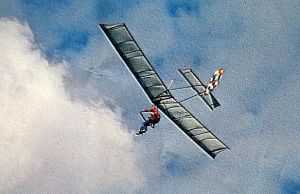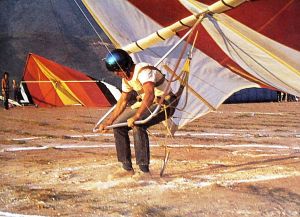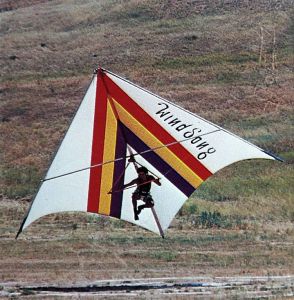Home (contents) → Hang gliding → Hang gliding 1974 part 3
Hang gliding 1974 part 3
This page continues from Hang gliding 1974 part 2.
The images here are artistic derivations of contemporary photos. See Copyright of early hang gliding photos.
Tommy
A politician in San Diego is campaigning on the promise to eliminate us.
— Photographer Leroy Grannis writing in Hang Glider, Fall 1974

The Ken Russell movie Tommy, filmed in 1974, featured Roger Daltry of rock band The Who apparently launching from a castle tower near Portsmouth, England, in an all-white Birdman standard Rogallo. He flew shirtless and helmet-less while singing a long-forgotten song, thus causing dozens of mods and rockers on the streets below, some wearing World War 2 German steel helmets, to stop fighting and instead break out into spontaneous gyrations while they looked up at him in awe.
The point is that, with the advent of hang gliding, you no longer needed to use a multi-million dollar airplane to drop napalm on iron-age villagers in support of a corrupt capitalist regime half a world away (fighting a brutal communist regime) to be a flying hero.
See also Birdman and Solar Wings of Wiltshire, England.
Rogallo versus Quicksilver in colour


The pilot in the preceding image was known as ‘Spoon’ (almost certainly Larry Witherspoon) and the guy watching from in front of his glider is Dave Meyers. For more of Larry Witherspoon see Hang gliding late 1980s and Hang gliding 1994 and 1995.

See the Eipper-Formance of Torrance, California related topics menu.

For more of Richard Hovey’s photos, see under School for perfection and More Rogallos, both in Hang gliding 1973 part 2.


The parabolic-curved leading edge Seagull III was first produced when most Rogallo wings were of 80 degree nose angle. Ninety degree nose angle wings were thought of as for experts only, perhaps because a right-angle was feared to be a physical limit in a self-inflating fabric wing. Yet the Seagull had a wide nose angle of 102 degrees.
Rick Poynter’s Pacific Kites in New Zealand manufactured copies of the Seagull III. Sail-maker (and future Olympic sailor) Graham Deegan bought one and he modified the sail with shaped seams and superior sailcloth. The performance difference between his wing and production gliders was marked(1). For more about Rick Poynter and Pacific Kites, see Lancer in Graeme Bird’s hang gliders and for Graham Deegan’s later contributions to hang glider development, see Airwave in Hang gliding early 1980s part 2.

This photo of Nick Regan, an early editor of the British hang gliding and powered ultralight magazines, shows that the Seagull 3 did not fold into as neat a bundle as a wing with straight leading edges. The same applied to the Wasp CB240, which likely used Nick’s Seagull as its prototype. The site here appears to be Steyning on the Sussex Downs, southern England.
Author’s reminiscence: I believe that Nick built this Seagull 3 himself. According to other pilots who I spoke to, the Wasp was an improvement on the Seagull.
Nick Regan also flew a Quicksilver, incidentally. For more about Nick, see South Downs in Hang gliding early 1980s part 1.
Another British manufacturer, Pegasus (not to be confused with the later Pegasus Aviation) also made a similar wing with permanently curved leading edges.
They were great gliders but I had little enthusiasm for any Seagull mainly because they were a pain to transport compared to straight leading edge gliders.
— Ken de Russy, chief instructor at the Santa Barbara Hang Glider Emporium

Seagull attempted to combine the advantages of the Quicksilver ‘semi rigid’ monoplane with the advantages of the Rogallo in their Seagull 5. A closer-up image of the fin and rudder appears later on this page.
See also the Seagull Aircraft of Santa Monica, California related topics menu.



The ‘official organ’ of the (UK) National Hang Gliding Association was the Illustrated Monthly Flypaper. The September 1974 edition contained a report and photos of an early British hang gliding competition held at Cam Long in Shropshire.
Winter escape: The 1974 U.S. nationals
The 1974 US nationals were held at Escape Country, California, in late December 1974 and early January 1975. In the flex-wing (Rogallo) class, Bob Wills won first place, Chris Wills second, and Chris Price third, all flying Swallowtails.
For a painting based on the sunset photo, see under External links later on this page.



Prizes for professional contests are climbing into the thousands of dollars.
— Don Dedera(2)








See Dave Cronk, Bob Lovejoy, and the Quicksilver in Cronk works.


See the related topics menu Ultralight Products of California and Utah.

While Hang Glider magazine featured the color photos of Leroy Grannis, Wings Unlimited, based in Topeka, Kansas, showed mainly color photos by W.A. Allen. The cover photo here is of the prototype Dragonfly, likely with its designer Roy Haggard aboard.
As a boy, Jim sometimes hiked to the top of Saddleback Mountain. “It’s a funny thing about that,” he muses, “When I got to the top, I used to wish there was some way I could fly back down. Who would have thought people would some day be doing it?”
— Maralys Wills (mother of the manufacturer Wills Wing) quoting Escape Country entrepreneur and hang glider pilot Jim Robinson in Ground Skimmer, August 1973

The ‘surfing model’ of hang gliding in southern California, when top-to-bottom flights were the norm, naturally lent itself to the concept of the flight park, much like the motocross park. Indeed, the winner of the 1974 U.S. nationals, Bob Wills, was a motocross racer as was 1974 British champion Brian Wood, along with some other notable hang gliding Brits including Ken Messenger and Len Hull.

Escape Country featured a motocross track, as did nearby Saddleback Park, both of which were also hang gliding competition venues. Note MX racing Sundays under Bicycling. This was an early manifestation of BMX racing.
However, the ‘surfing model’ of hang gliding was becoming an outdated concept. Hang gliders were already starting to fly cross country, thus escaping the confines of venues like Escape Country.
This topic continues in Hang gliding 1974 part 4.
External links
Film taken at the Escape Country Annie Green Springs event (Dave Cronk narrating) in Big Blue Sky, 2008, by Bill Liscomb on YouTube starting at 27 minutes 47 seconds
Revisiting Escape Country launch zones 2016 on the US Hawks forum
Swallowtail in Painted history of hang glider design part 1 on Brave guys and beautiful dolls for a painting based on the Leroy Grannis sunset photo at Escape Country
Taras Kiceniuk flying his Icarus 5 at the Escape Country Annie Green Springs event in Big Blue Sky, 2008, by Bill Liscomb on YouTube starting at 38 minutes 19 seconds
External links to photos by Jack
These exceptionally clear color photos are by ‘Jack’ in this topic on the hangliding.org forum:
Icarus V on display with its structure exposed
Swallowtail landing on the target. This side view shows the low billow of the Swallowtail compared to the standard Rogallo.
Transporting an Icarus 5 on a truck
Sources and references
1. Graham Deegan’s Seagull III copy: Gib Eggen writing in Whole Air, April 1986
2: Hang Gliding: The Flyingest Flying by Don Dedera and Stephen McCarroll, 1975